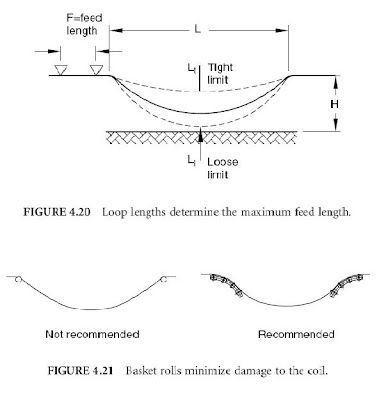Free Hanging Loop
In many cases, the difference between the length of the loose loop and the tight loop (almost straight line as shown in Figure 4.20) is sufficient to feed the press. Usually, reference literature and suppliers provide equations to calculate the space (length) required for adequate loop (marked as “L” in Figure 4.20).
It is prudent to apply fixed or adjustable “basket rolls” (Figure 4.21) at both ends of the loop to avoid coil breaks.
Although a free hanging chain or rope follows a predictable geometric shape, the stiffness of the strip will change that shape. If punching or notching significantly reduces the strip’s cross-section, then the strip’s resistance to bending under its own weight can drastically change at that point. These changes should be taken into consideration when the distance between the supports (L) is calculated.
(Halmos G. T., Roll forming handbook, sector 4 p. 12)
Free Hanging Loop with Pit
For long punching patterns (e.g., 3 to 10 ft or 1 to 3 m), frequently there is not enough depth between the supports and the floor to provide sufficient length for the fast feeding. In this case, the designer may recommend using pits (Figure 4.22). Pits can be useful but they are expensive, not safe, and will create additional expenses when the lines are moved.

(Halmos G. T., Roll forming handbook, sector 4 p. 13)
Quantity Production
Quantity production involves the mass production of single parts on single pieces of equipment. It typically involves standard machines (such as stamping presses) equipped with special tooling (e.g., dies and material handling devices), in effect dedicating the equipment to the production of one part type. Typical layouts used in quantity production are the process layout and cellular layout.
(Groover M. P., Fundamentals of modern manufacturing: Materials, processes and systems, p. 19)
Flow Line Production
Flow line production involves multiple pieces of equipment or workstations arranged in sequence, and the work units are physically moved through the sequence to complete the product. The workstations and equipment are designed specifically for the product to maximize efficiency.
(Groover M. P., Fundamentals of modern manufacturing: Materials, processes and systems, p. 19)

No comments:
Post a Comment